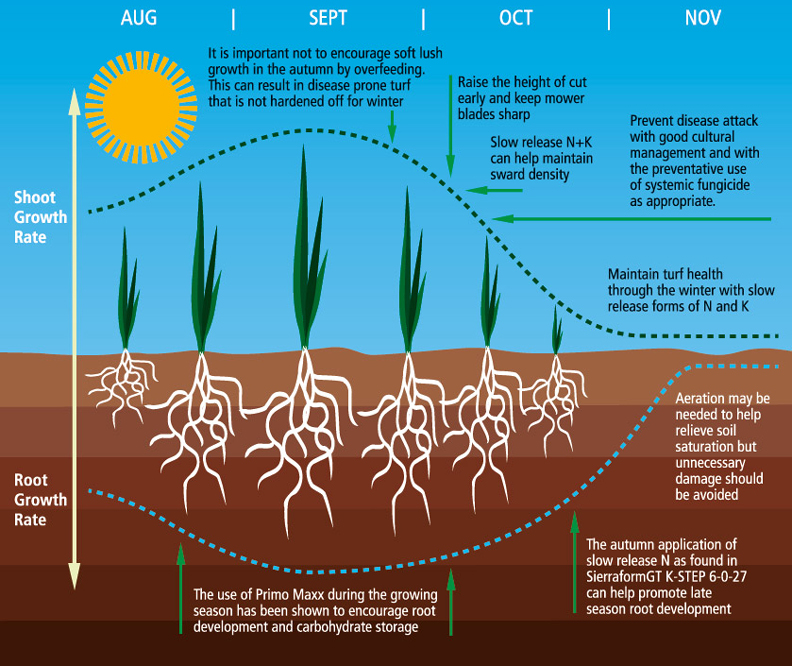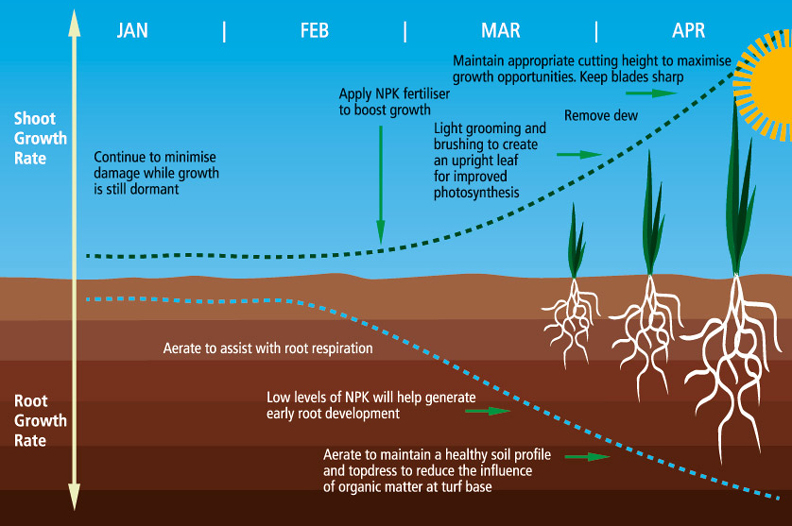A winters toil
Winter is a crucial time for golf clubs. Weather conditions become more difficult for turf maintenance but course performance and playability is still important to the golfers.
On this page:
Originally written in January 2014, contains updates from January 2023.
Winter is a crucial time for golf clubs. Weather conditions become more difficult for turf maintenance but course performance and playability is still important to the golfers, especially if they are thinking about their membership. With that in mind, it is necessary for Course Managers to produce ever higher standards during the winter, especially with their greens. This isn’t easy without growth!
The creep towards winter brings a drop in temperatures and shorter days. The resultant decline in turf growth and recovery severely limits the possibilities for surface preparation. Wetter weather commonly creates soils that remain saturated for months to weaken the turf. Pest and disease activity at this time can create additional problems of scarring and damage. Golfers still want to play during the winter, and this causes further decline. At the time of year when turf growth slows down, the pressures mount and they can cause a significant deterioration in the quality of the turf surface. So, what can be done to guard against winter decline?

Growth patterns above and below ground
Well, you are no strangers to meeting the challenge of increasing levels of expectation and overcoming difficult situations. The general aim is to strengthen the turf through autumn, protect it from damage during winter, then revitalise in spring for quick recovery. This sounds simple, but there are a large number of factors that you need to get right to succeed. Getting turf through the winter requires good cultural practice combined with the proper use of supporting technologies.
A sporting chance
Above all else, give your turf a chance by creating a healthy growing environment. Maximising light penetration and creating airflow is essential, so surrounding tree and understory vegetation management is vital. Good drainage is also essential to prevent the soil becoming saturated for long periods. Aeration may be necessary to keep the soil oxygenated and help keep roots functioning. Ongoing organic matter management in the upper soil profile will stand you in good stead, especially during the winter.

Autumn – the descent into dormancy
Autumn decline
Autumn is the time when growth tails off. To prepare the turf for winter you need to be proactive, alert and preventative in your approach.
Key factors for consideration during your autumn preparation phase:
- Optimise turf health during late summer with appropriate nutrition (not too much N)
- Continue to use Primo Maxx (2023 equivalent would be Primo Maxx II) while strong growth is still available to help encourage carbohydrate storage. It is these energy reserves that will help support plant health during the winter
- Moving through the autumn, sustain turf health by using slow release sources of N and K (such as those in SierraformGT K-STEP 6-0-27 +2MgO +TE). This improves stress tolerance, favours root development and reduces the risk of disease activity
- Allow the turf to acclimatise to the oncoming winter. Don’t force too much top growth or push too hard maintaining summer playing qualities for too long into the autumn
- Prevent disease outbreaks with ongoing cultural management (dew removal, iron, phosphite) along with appropriate systemic fungicides applied preventatively to protect the turf from attack while still growing. Propiconazole, the active ingredient in Banner Maxx, for instance, is formulated for quick uptake and distribution through the plant to give disease control and protection even when temperatures begin to decline (2023 equivalents would be Instrata Elite and Ascernity in ROI)
- Raise your height of cut early enough to maximise any remaining opportunities for photosynthesis. This helps the turf strengthen and build energy reserves
- It is important to use sharp blades when mowing to prevent unnecessary damage. A ragged cut takes a lot of energy for the plant to repair
- Finalise any damaging treatments while turf it still growing to achieve full recovery before the onset of winter dormancy.
Winter care
Winter is generally the time for silent running, but there is still a great deal you can do to maintain turf health, performance and playability. You are aiming to keep all damage to a minimum. The turf will be actively functioning to some degree if conditions are suitable, and you can take advantage of such opportunities. Anything you are able to do to improve the growing environment will greatly assist plant functioning.

Winter dormancy – prevent damage
Key factors for winter management include:
- Install drainage and improve light and airflow as a matter of priority
- Minimise damage by managing wear and appraising the need for mechanical treatments
- Remove dew to optimise any growth opportunities and reduce the risk of disease attack
- Apply slow-release N and K (as found in K-STEP 6-0-27 +2MgO +TE) if growth opportunities are available
- Use iron products to help harden the sward
- If you are mowing, USE SHARP BLADES!
- Prevent disease outbreaks. Pathogens can develop quickly and cause significant damage before symptoms become visible. Fludioxynil, the active ingredient in Medallion TL and Instrata (2023 equivalent would be Instrata Elite) for instance, can be used to control inoculum in the upper profile to help reduce the potential for disease attacks, especially if the turf should subsequently become covered in snow
Winter is when you reap the rewards of your preparation work, but you still need to keep actively managing the ongoing situation. There will be opportunities to generate recovery but generally you are working hard to prevent any form of deterioration. If you can get the greens through the winter in good shape, you stand a better chance of quick recovery in the spring.
Spring forward
Spring always seems a long time coming but the pressure to create summer surfaces as early as possible is always present. You still need to work hard to prevent deterioration, but you also want to set conditions in place for a quick recovery when conditions allow. Winter drainage and tree removal work will pay dividends when trying to hasten spring recovery.

Spring – generating growth and recovery
In spring, well-timed early season aeration and top dressing will help reoxygenate the soil. NPK feeds such as Greenmaster Pro-Lite Cold Start 11-5-5 +8Fe can help initiate early spring growth, especially in colder conditions when soil P might not be available. Light grooming and brushing helps to create an upright leaf to stimulate early season photosynthesis. Keep your height of cut raised for as long as possible for the same reason. Manage play to prevent deterioration and set about initiating your early season refinement programme as soon as growth allows. Communicate to members that the onset of growth is primarily dependent upon soil temperatures, moisture content and day length to temper their expectations.
So, winter can be a tough time for greenkeeping but there is a great deal that you can do to sustain turf health and maintain playing qualities. Sound cultural practice coupled with the use of supporting technologies will get you through. We call this type of approach “integrated turf management”.







